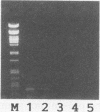Abstract
Direct polymerase chain reaction (PCR)-based detection with fecal specimens is hampered by inhibitory compounds, such as bilirubin and bile salts. These fecal compounds showed significant inhibition of PCR at low concentrations (10 to 50 micrograms/ml). For direct PCR analysis, fecal samples must be diluted 500-fold to overcome inhibition. Therefore, the magnetic immuno PCR assay (MIPA), which combines immunomagnetic separation by using specific monoclonal antibodies and PCR, was used to directly detect salmonellae in feces from humans. Immunomagnetically extracted stool samples needed to be diluted only 10-fold when 1 microgram of T4 gene 32 protein was added to the PCR. The MIPA sensitivity obtained was 10(5) CFU/ml of feces. A panel of monoclonal antibodies specific for Salmonella serogroups A to E was used to extract salmonellae from clinical samples. MIPA detection of salmonellae occurred with 11 out of 14 stool samples stored at 4 degrees C for 2 months. MIPA detection of salmonellae in stool samples is a promising, fast method for detection and identification.
Full text
PDF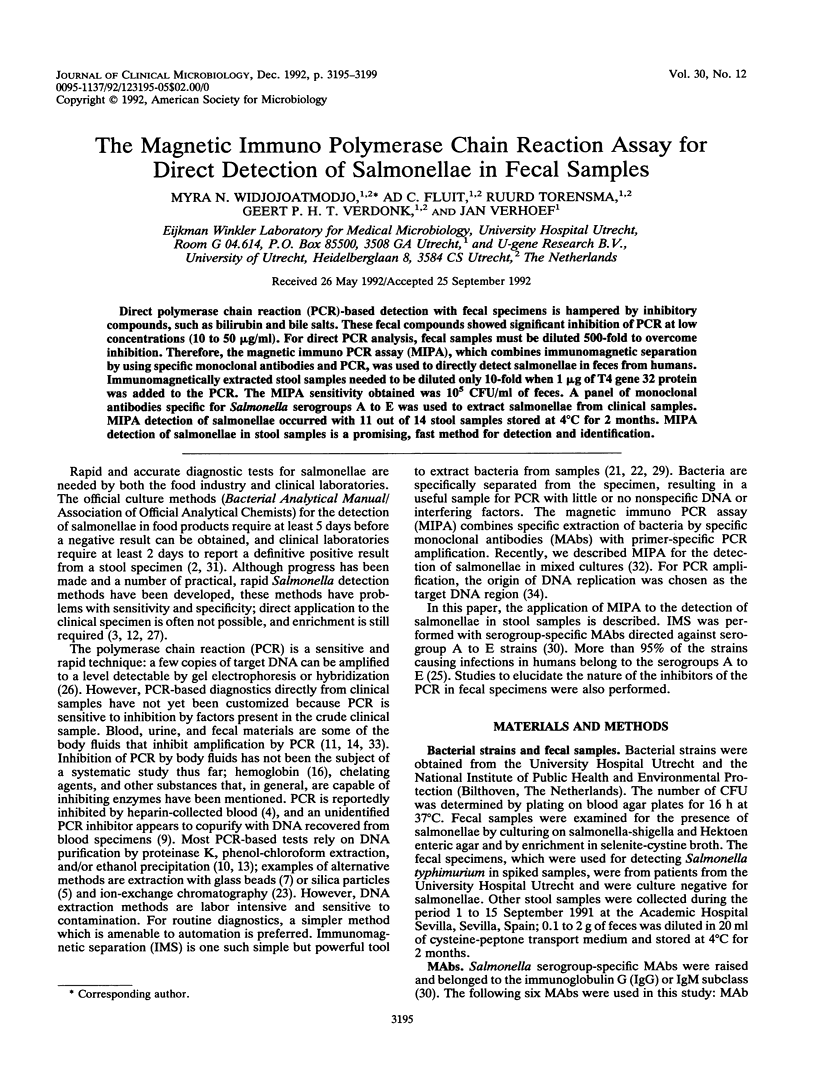
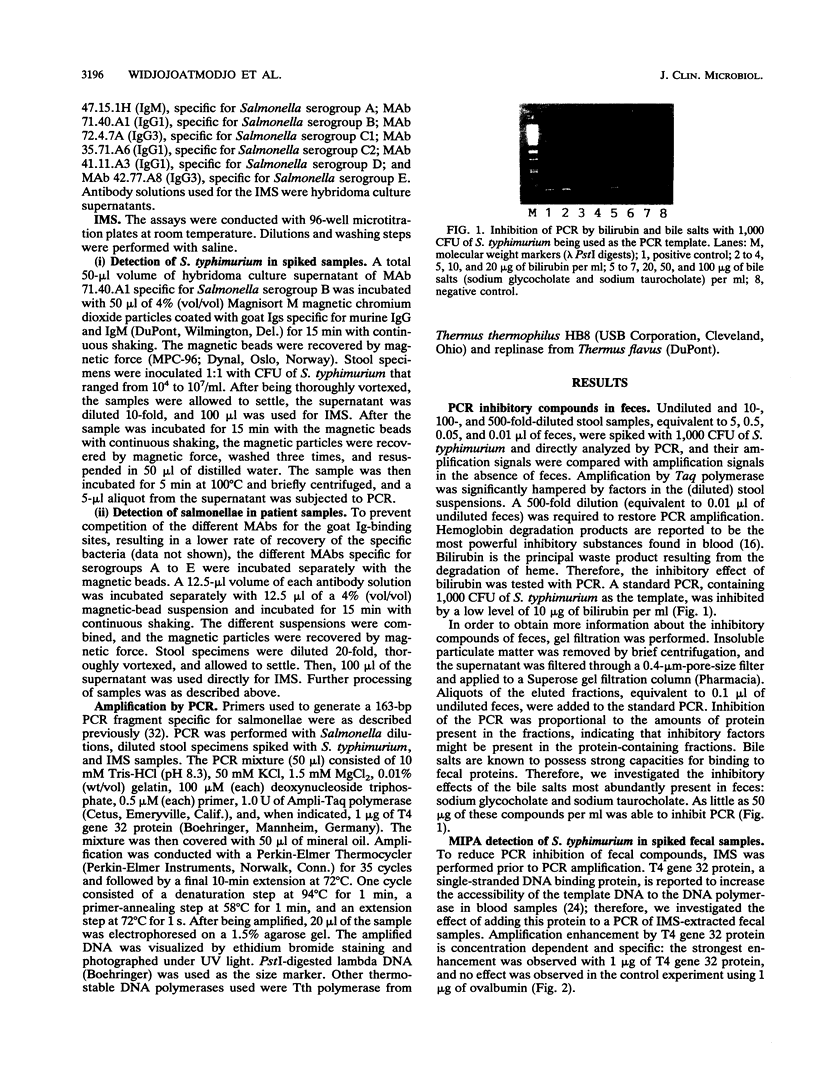
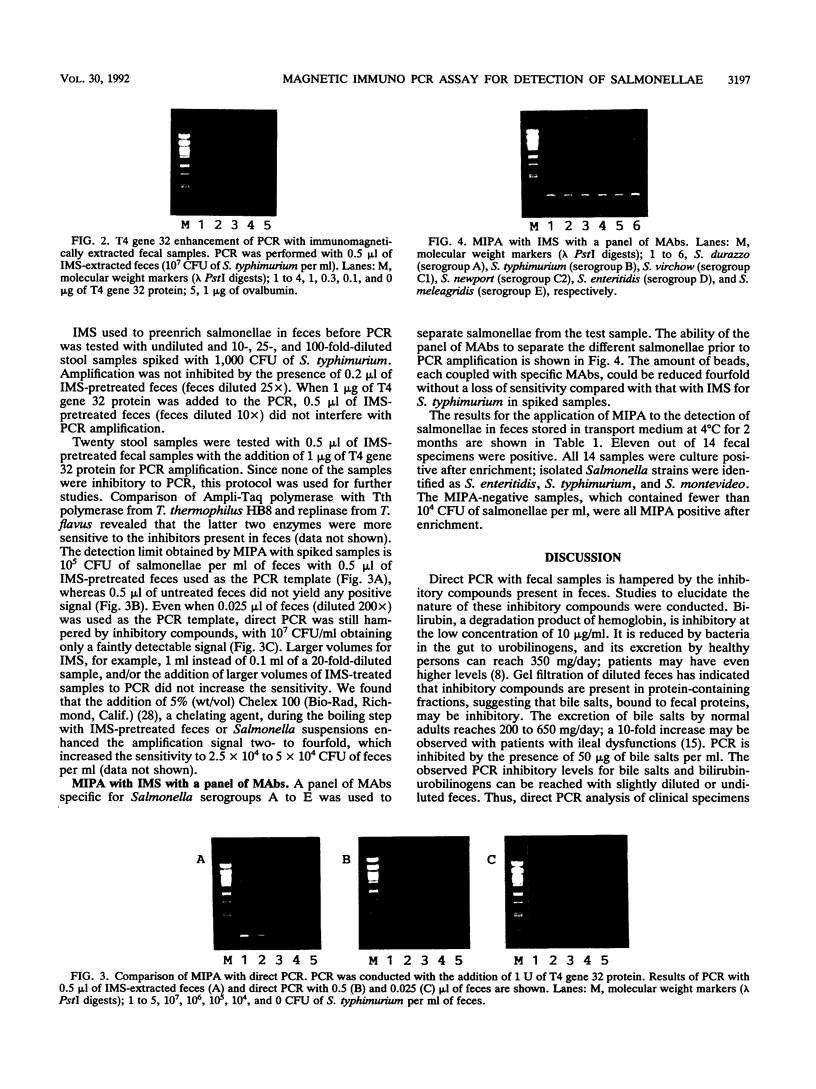
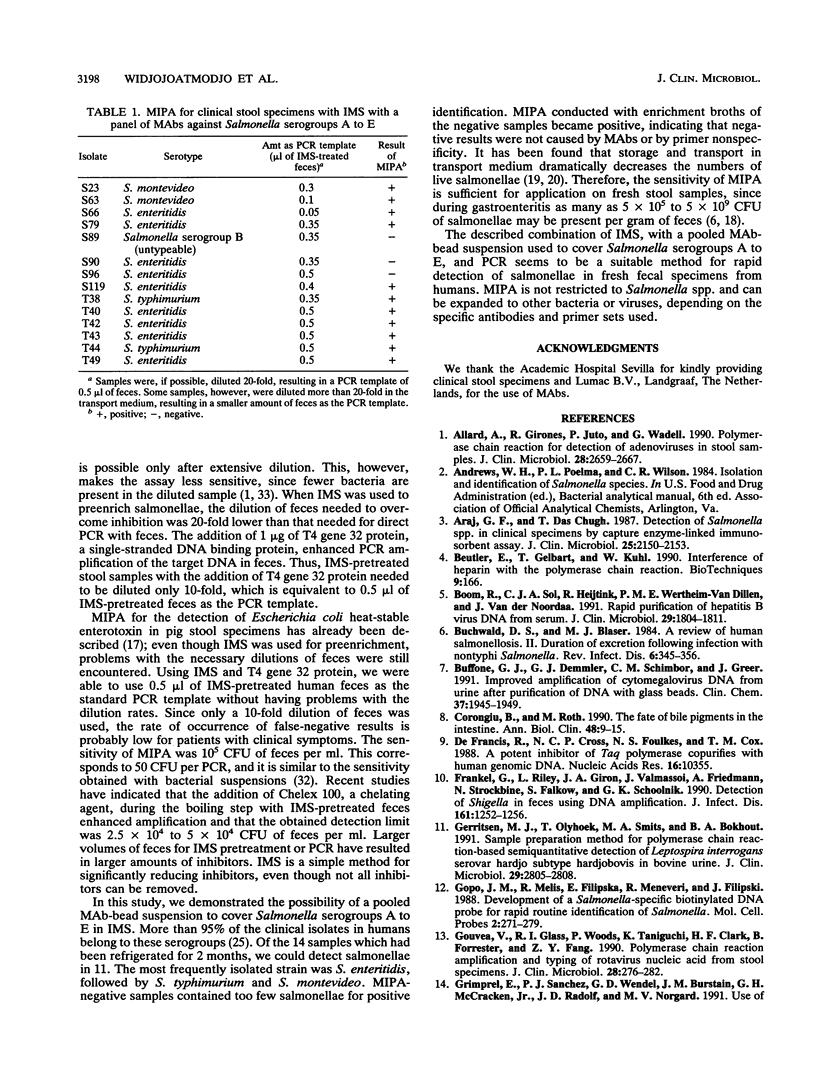
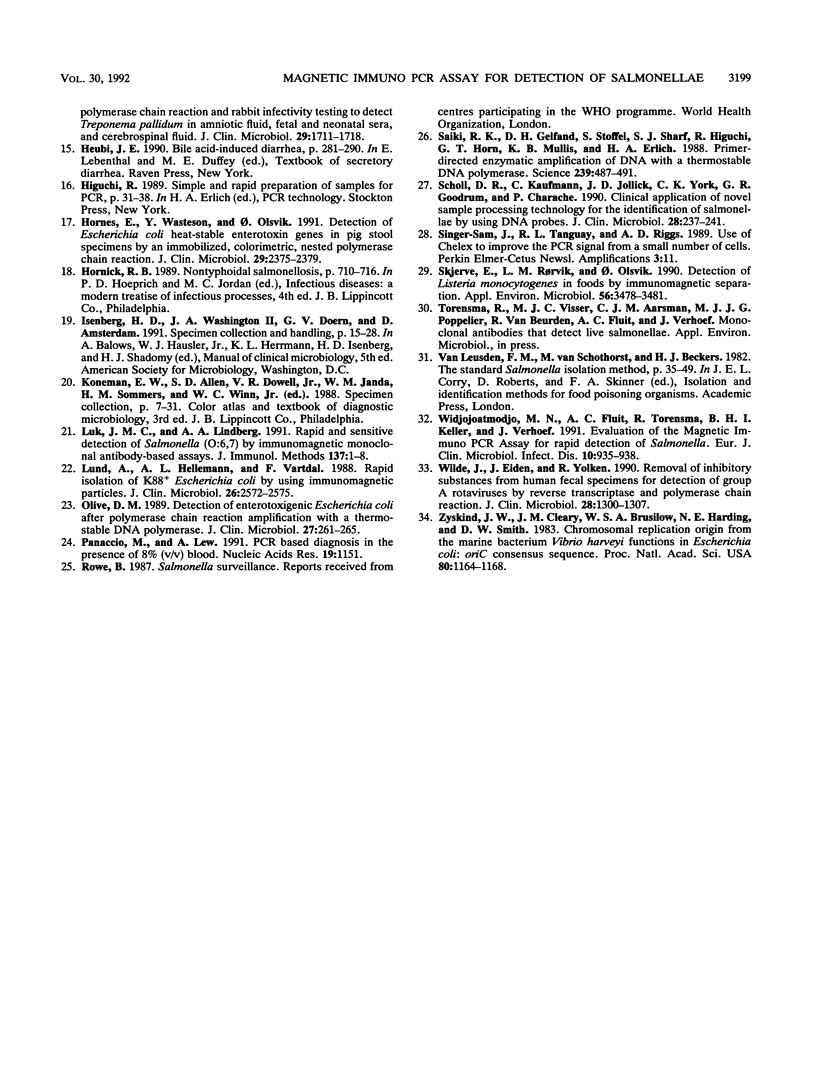
Images in this article
Selected References
These references are in PubMed. This may not be the complete list of references from this article.
- Allard A., Girones R., Juto P., Wadell G. Polymerase chain reaction for detection of adenoviruses in stool samples. J Clin Microbiol. 1990 Dec;28(12):2659–2667. doi: 10.1128/jcm.28.12.2659-2667.1990. [DOI] [PMC free article] [PubMed] [Google Scholar]
- Araj G. F., Chugh T. D. Detection of Salmonella spp. in clinical specimens by capture enzyme-linked immunosorbent assay. J Clin Microbiol. 1987 Nov;25(11):2150–2153. doi: 10.1128/jcm.25.11.2150-2153.1987. [DOI] [PMC free article] [PubMed] [Google Scholar]
- Beutler E., Gelbart T., Kuhl W. Interference of heparin with the polymerase chain reaction. Biotechniques. 1990 Aug;9(2):166–166. [PubMed] [Google Scholar]
- Boom R., Sol C. J., Heijtink R., Wertheim-van Dillen P. M., van der Noordaa J. Rapid purification of hepatitis B virus DNA from serum. J Clin Microbiol. 1991 Sep;29(9):1804–1811. doi: 10.1128/jcm.29.9.1804-1811.1991. [DOI] [PMC free article] [PubMed] [Google Scholar]
- Buchwald D. S., Blaser M. J. A review of human salmonellosis: II. Duration of excretion following infection with nontyphi Salmonella. Rev Infect Dis. 1984 May-Jun;6(3):345–356. doi: 10.1093/clinids/6.3.345. [DOI] [PubMed] [Google Scholar]
- Buffone G. J., Demmler G. J., Schimbor C. M., Greer J. Improved amplification of cytomegalovirus DNA from urine after purification of DNA with glass beads. Clin Chem. 1991 Nov;37(11):1945–1949. [PubMed] [Google Scholar]
- Corongiu B., Roth M. Le devenir des pigments biliaires dans l'intestin. Ann Biol Clin (Paris) 1990;48(1):9–15. [PubMed] [Google Scholar]
- Frankel G., Riley L., Giron J. A., Valmassoi J., Friedmann A., Strockbine N., Falkow S., Schoolnik G. K. Detection of Shigella in feces using DNA amplification. J Infect Dis. 1990 Jun;161(6):1252–1256. doi: 10.1093/infdis/161.6.1252. [DOI] [PubMed] [Google Scholar]
- Gerritsen M. J., Olyhoek T., Smits M. A., Bokhout B. A. Sample preparation method for polymerase chain reaction-based semiquantitative detection of Leptospira interrogans serovar hardjo subtype hardjobovis in bovine urine. J Clin Microbiol. 1991 Dec;29(12):2805–2808. doi: 10.1128/jcm.29.12.2805-2808.1991. [DOI] [PMC free article] [PubMed] [Google Scholar]
- Gopo J. M., Melis R., Filipska E., Meneveri R., Filipski J. Development of a Salmonella-specific biotinylated DNA probe for rapid routine identification of Salmonella. Mol Cell Probes. 1988 Dec;2(4):271–279. doi: 10.1016/0890-8508(88)90011-4. [DOI] [PubMed] [Google Scholar]
- Gouvea V., Glass R. I., Woods P., Taniguchi K., Clark H. F., Forrester B., Fang Z. Y. Polymerase chain reaction amplification and typing of rotavirus nucleic acid from stool specimens. J Clin Microbiol. 1990 Feb;28(2):276–282. doi: 10.1128/jcm.28.2.276-282.1990. [DOI] [PMC free article] [PubMed] [Google Scholar]
- Grimprel E., Sanchez P. J., Wendel G. D., Burstain J. M., McCracken G. H., Jr, Radolf J. D., Norgard M. V. Use of polymerase chain reaction and rabbit infectivity testing to detect Treponema pallidum in amniotic fluid, fetal and neonatal sera, and cerebrospinal fluid. J Clin Microbiol. 1991 Aug;29(8):1711–1718. doi: 10.1128/jcm.29.8.1711-1718.1991. [DOI] [PMC free article] [PubMed] [Google Scholar]
- Hornes E., Wasteson Y., Olsvik O. Detection of Escherichia coli heat-stable enterotoxin genes in pig stool specimens by an immobilized, colorimetric, nested polymerase chain reaction. J Clin Microbiol. 1991 Nov;29(11):2375–2379. doi: 10.1128/jcm.29.11.2375-2379.1991. [DOI] [PMC free article] [PubMed] [Google Scholar]
- Luk J. M., Lindberg A. A. Rapid and sensitive detection of Salmonella (O:6,7) by immunomagnetic monoclonal antibody-based assays. J Immunol Methods. 1991 Mar 1;137(1):1–8. doi: 10.1016/0022-1759(91)90387-u. [DOI] [PubMed] [Google Scholar]
- Lund A., Hellemann A. L., Vartdal F. Rapid isolation of K88+ Escherichia coli by using immunomagnetic particles. J Clin Microbiol. 1988 Dec;26(12):2572–2575. doi: 10.1128/jcm.26.12.2572-2575.1988. [DOI] [PMC free article] [PubMed] [Google Scholar]
- Olive D. M. Detection of enterotoxigenic Escherichia coli after polymerase chain reaction amplification with a thermostable DNA polymerase. J Clin Microbiol. 1989 Feb;27(2):261–265. doi: 10.1128/jcm.27.2.261-265.1989. [DOI] [PMC free article] [PubMed] [Google Scholar]
- Panaccio M., Lew A. PCR based diagnosis in the presence of 8% (v/v) blood. Nucleic Acids Res. 1991 Mar 11;19(5):1151–1151. doi: 10.1093/nar/19.5.1151. [DOI] [PMC free article] [PubMed] [Google Scholar]
- Saiki R. K., Gelfand D. H., Stoffel S., Scharf S. J., Higuchi R., Horn G. T., Mullis K. B., Erlich H. A. Primer-directed enzymatic amplification of DNA with a thermostable DNA polymerase. Science. 1988 Jan 29;239(4839):487–491. doi: 10.1126/science.2448875. [DOI] [PubMed] [Google Scholar]
- Scholl D. R., Kaufmann C., Jollick J. D., York C. K., Goodrum G. R., Charache P. Clinical application of novel sample processing technology for the identification of salmonellae by using DNA probes. J Clin Microbiol. 1990 Feb;28(2):237–241. doi: 10.1128/jcm.28.2.237-241.1990. [DOI] [PMC free article] [PubMed] [Google Scholar]
- Skjerve E., Rørvik L. M., Olsvik O. Detection of Listeria monocytogenes in foods by immunomagnetic separation. Appl Environ Microbiol. 1990 Nov;56(11):3478–3481. doi: 10.1128/aem.56.11.3478-3481.1990. [DOI] [PMC free article] [PubMed] [Google Scholar]
- Widjojoatmodjo M. N., Fluit A. C., Torensma R., Keller B. H., Verhoef J. Evaluation of the magnetic immuno PCR assay for rapid detection of Salmonella. Eur J Clin Microbiol Infect Dis. 1991 Nov;10(11):935–938. doi: 10.1007/BF02005447. [DOI] [PubMed] [Google Scholar]
- Wilde J., Eiden J., Yolken R. Removal of inhibitory substances from human fecal specimens for detection of group A rotaviruses by reverse transcriptase and polymerase chain reactions. J Clin Microbiol. 1990 Jun;28(6):1300–1307. doi: 10.1128/jcm.28.6.1300-1307.1990. [DOI] [PMC free article] [PubMed] [Google Scholar]
- Zyskind J. W., Cleary J. M., Brusilow W. S., Harding N. E., Smith D. W. Chromosomal replication origin from the marine bacterium Vibrio harveyi functions in Escherichia coli: oriC consensus sequence. Proc Natl Acad Sci U S A. 1983 Mar;80(5):1164–1168. doi: 10.1073/pnas.80.5.1164. [DOI] [PMC free article] [PubMed] [Google Scholar]
- de Franchis R., Cross N. C., Foulkes N. S., Cox T. M. A potent inhibitor of Taq polymerase copurifies with human genomic DNA. Nucleic Acids Res. 1988 Nov 11;16(21):10355–10355. doi: 10.1093/nar/16.21.10355. [DOI] [PMC free article] [PubMed] [Google Scholar]




